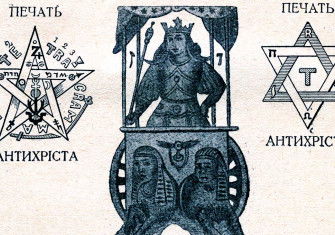Blood Libel: The Origins of a Conspiracy Theory
Richard Sugg explains the origins of the term ‘Blood Libel’, an antisemitic ritual murder myth with a long and ugly history.

Controversy has surrounded the recent claims of American politician, Sarah Palin, that she has been the victim of a 'blood libel', after suggestions that her campaign rhetoric may have prompted the shootings in Arizona on January 8th. Just what is a 'blood libel', and what does it say about historic relations between Christians and Jews?
In Christopher Marlowe's play The Jew of Malta (c.1590) two friars discuss a terrible crime supposedly committed by the eponymous Jew, Barabas. Before Friar Bernardine has quite got to the actual deed, his colleague, Jacomo, anticipates him: 'What, has he crucified a child?' Although Barabas has not, the seemingly wild accusation would, for many of Marlowe's audience, have been quite natural and credible. For centuries Christians had repeated this charge. The rich and the poor, the illiterate and the educated alike firmly believed that, annually, around Easter, Jews abducted Christian children, circumcised and crucified them, and used their blood to bake bread which was then ritually consumed. In unsolved child-murder cases, Jews could be accused, prosecuted and executed for this legendary crime. The belief was spread in both official records and popular media. There were ballads, particularly concerning 'Little Hugh', a Lincoln child who was found murdered in the 13th century. There were pictures: to this day, visitors to Loddon Church in Norfolk can still see Jews gathered around a bleeding, crucified child, the legendary William of Norwich.
Marlowe, to his credit, probably did not believe any of this. But many of his highly educated peers did. The claim was repeated by the Protestant polemicist John Foxe, and John Donne openly voiced the belief from his pulpit on Christmas Day 1625. The travel writer Samuel Purchas labelled it 'the Jewish crime', and if Shakespeare is relatively balanced in his treatment of Shylock, the idea of a Jew seeking to cut out a Christian's heart for motives of sheer malice is hardly miles away from the standard libel. In 1677, the tale of a Christian girl, supposedly murdered and surgically bled onto linen cloths at Psorizheimin 1271, was stated as fact by John Webster - a man who was one of the most vigorous opponents of the British witch-hunts.
This peculiarly dark secret of Christian antisemitism died very hard indeed. I can still recall a lecture on blood libels given to us at Leeds University in the early nineties by the Jewish scholar Frank Felsenstein. Startled as I was by the lecture itself, what I did not know at the time was this: as a school-child in the 1950s, Felsenstein had had the blood libel accusations repeated to him with immense conviction by a sometime friend, who insisted that both of his parents vouched for these claims. James Shapiro tells, meanwhile, of how the scholar Montague Summers (d.1948) claimed to have found 'quite conclusive' evidence for Jewish ritual murders, citing in particular a case from Szydlow in Poland, where, 'in 1597 ... the victim was put to death in exquisite tortures, the blood and several members of the body being partaken of by the murderers'. Summers' book was reprinted as late as 1973. Perhaps still more insidious was John Harvey Hooper's best-selling postwar history textbook, in which schoolteachers and children could read of those Jewish ritual murders attested by ‘unassailable’ proof in public records'. Whilst this work was withdrawn by its publishers only in the 1980s, it was around the turn of the millennium that guides at Lincoln Cathedral were repeating the tale of 'Little Hugh' as though legends of his Jewish killers were purely factual. One recent twist in this long narrative of mythicised antisemitism is peculiarly surprising. In 2007, Ariel Toaff, son of the chief rabbi in Rome [sic] had to withdraw his book, Passovers of Blood, after a storm of controversy followed its claims that some Ashkenazy Jews of the Middle Ages had indeed used blood in ritual ceremonies.
Just where did the Blood Libel myth come from? Bill Ellis has shown that it is in fact one of those 'urban legends' which can be peculiarly adaptable, as well as durable. Ironically enough, versions of it were first repeated about the early Christians, around the time of the Church Father Tertullian (died c.225AD). In North America in the late 20th century, black, hispanic, or even just 'hippy' gangs were accused of kidnapping and castrating white children. Here there is more racism than religion involved; but, once again, there is no evidence whatsoever for such rumours.
Writing immediately after Palin's remarks, Stephen Bates emphasised that 'the blood libel refers specifically to perhaps the most notorious verse in the Bible: Matthew 27:25' - "His blood be on us and on our children" - a text 'which has been used by some Christians to persecute Jews for nearly 2,000 years. That it should be used by an avowedly Christian politician about a Jewish one just takes crassness and insensitivity to a new level'. Bates is right. The response of Alan Dershowitz - that 'blood libel', like 'crusade' or 'crucify' has become a free-floating term, which can now be used regardless of religion or ethnicity - is thought-provoking. But in cases like this, we have a special responsibility - to history, and its darker secrets - to know what such a phrase means before we use it. Many people do not know the details of blood libel accusations. If they did, they would probably realise that this is perhaps the single most glaring piece of evidence for a quite visceral and deep-rooted Christian antisemitism.
And even those who do know of the medieval and early modern slurs may be unaware of how long they have survived in the minds of some educated Christians. For a long time, hating the Jews was an easy way to prove that you were a good Christian. Compare this exchange, c.1961, from the film version of Lynn Barber's recent memoir, An Education:
Headmistress: ‘He’s a Jew? You’re aware, I take it, that the Jews killed our Lord?’
Jenny: ‘And you’re aware, I suppose, that our Lord was Jewish?’
Headmistress: ‘I suppose he told you that. We’re all very sorry about what happened during the war. But that’s absolutely no excuse for that sort of malicious and untruthful propaganda.’
The first line of this dialogue comes from Barber's own memory of the meeting; the following ones seem to have been added for dramatic effect by the filmmakers. But there is more than a grain of truth in such dramatic licence. Christ was Jewish, and there is very little evidence that he was interested in inventing a universal religion called Christianity. And this is something which most Christians prefer to forget.
Sometimes, people can have a peculiarly twisted hostility toward those they have already wronged. Christianity stole the Old Testament; and arguably stole Christ too, falsely abstracting him from his Jewish roots. Perhaps it is this buried guilt which has made Christian antisemitism - and its attendant myths - such powerful forces for almost two millennia. At any rate, the antagonism is far from over.Writing in the Guardian in April 2010, Tom Kington cited the 81-year-old Italian Bishop Giacomo Babini, who had claimed that accusations of widespread clerical sex abuse were the result of a covert ‘Zionist attack’. 'Allegedly speaking to the Catholic website Pontifex, Babini was quoted as saying: ‘They do not want the church, they are its natural enemies. Deep down, historically speaking, the Jews are God killers.'






